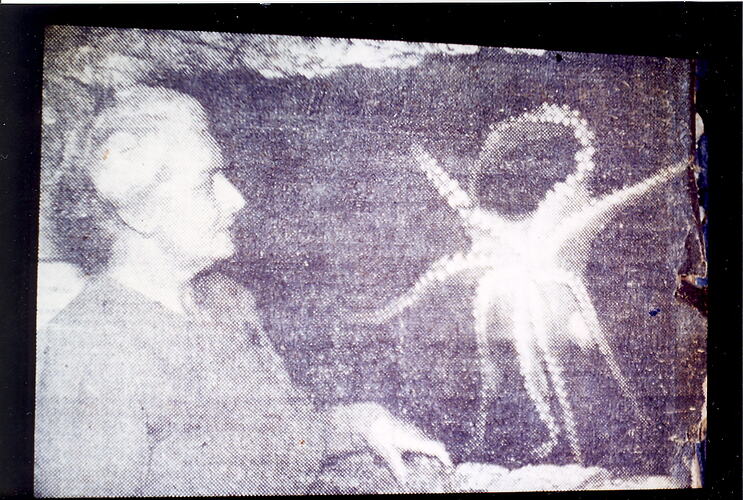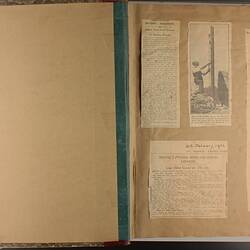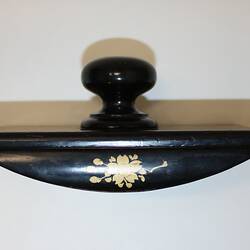Summary
Mrs Isabel A. Green (nee Menzies) served as Acting Secretary to Exhibition Trustees from August 1938 to October 1938 and Secretary from October 1938 to November 1955.
The Early Years
Isabel (Belle) Alice Green (nee Menzies), born 9 May 1893, was the third of five children and the only daughter of James and Kate Menzies. Dunstan (1996) describes Isabel as 'a beautiful and vivacious young woman of outstanding ability but denied the education being given to her four brothers and destined for "domestic duties" at home' (Dunstan 1996, p. 373). Belle went to the local state school in Jeparit then boarded with her grandmother while attending Humffray Street State School and Ellerslie College Ballarat (Rutledge 2007).
Red Cliffs
In December 1916 Isabel married RAAF pilot George Green a few days before he embarked with the 4th Field Artillery Brigade, Australian Imperial Force. After returning from the war, he became a stock and station agency administrator managing 33,000 acres of land at Red Cliffs being cleared for soldier settlement blocks. During her time at Red Cliffs, Isabel became the first secretary and president of Ballarat's Women's Club and Baby Health Centre leaving this position with a paid welfare nurse employed and the books financially sound.
Moving to Melbourne
In 1929 the family moved to Melbourne and with three children finances were tight, so Isabel convinced Sidney Myer to let her manage a service bureau and post office in the Myer Emporium. George became Secretary of the Exhibition Trust in August 1931. In 1933 Isabel continued to work as a Volunteer Auxiliary organiser at the Royal Melbourne Hospital, and in 1936 worked at the Argus newspaper, however this was a short career due to George's declining health (Rutledge 2007). Annabelle Dennehy, Isabel's granddaughter, recalls that she was also a great story-teller and cook (Dennehy 2013).
The Exhibition Building Years
In 1938 George passed away and Isabel was employed on a three month trial as Acting Secretary to the Exhibition Trustees. The Building was at its lowest ebb and the Supreme Court decision had not been made regarding the removal of the oval and bicycle track. On a salary of £400 per annum, with fuel, light and quarters, she dealt with the 'weight of the dome on her shoulders' (Dunstan 1996). Duties included the management and maintenance of the Main Hall, Ballrooms, Melbourne Branch of the War Memorial, Carpark, the Gardens, Fountains and the Building's interior and exterior.
Isabel's appointment met with much cogitation from the Trustees due to her gender particularly as she was responsible for the management of 13 full-time male staff and as many casuals. A foreman retained the keys to the Exhibition Building and she was not able to access entire rooms for two years. Some of the locked rooms contained photographs sent from France for the 1888 Exhibition and spare parts for the Exhibition organ and cyclorama. In a 'domestic' urge she wanted to give the entire site a good spring clean - for example, she disliked the 'fusty' mummy in the Egyptian Mummy Room, comparing it to 'Blackbeard's Chamber', and sold it to the National Museum for £5.
Later, in order to raise funds after the demise of the cyclorama, she sold a native canoe and other building materials at a yard sale. However, Isabel also recognised the significance of the site and rebutted journalists' claims, such as the Sun's Alfred Vivian's 1939 comment that the Building was a 'blot on the landscape'. Despite this, Isabel explained the role as the 'sort of work in which a woman's imagination and gift for attention to detail should be most valuable' (Dunstan 1996).
Later Years
On her retirement in December 1955, the Victorian Chamber of Manufactures honoured Isabel with a party and it is claimed she was 'the first to leave her role with her reputation intact' (Dunstan 1996, p. 373; Rutledge 2007). Furthermore, when Isabel was replaced by ex-RAAF officer Anthony Adams 'the newspapers did not ask how he felt taking over from a "mere woman"' (Dunstan 1996, p.376). Isabel eventually became secretary of the Kew branch of the Liberal Party and of the Australian-American Association. She was also a world traveller and staunch supporter of the Carlton football team. Isabel Green was appointed OBE in 1970 and died on 20 December 1984 at Camberwell and was cremated with the forms of the Uniting Church (Rutledge 2007).
References
Dunstan, David 1995, Victorian icon: the Royal Exhibition Building, Melbourne, Australian Scholarly Publishing, Kew, Vic
Rutledge, M 2007, 'Green, Isabel Alice (Isabel) (1893-1984)', Australian Dictionary of Biography, National Centre of Biography, Australian National University, http://adb.anu.edu.au/biography/green-isabel-alice-Isabel-12561/text22613
Dennehy A, 2013, A Portrait Of Isabel: The Story of Isabel Alice Green O.B.E. - The Female Menzies, Kindle Edition, https://www.amazon.com/Portrait-Isabel-Isabel-B-Menzies-ebook/dp/B00H4FBMVU?SubscriptionId=179EQG3F3QRNWT8WS602&tag=Trove08-20&linkCode=xm2&camp=2025&creative=165953&creativeASIN=B00H4FBMVU



